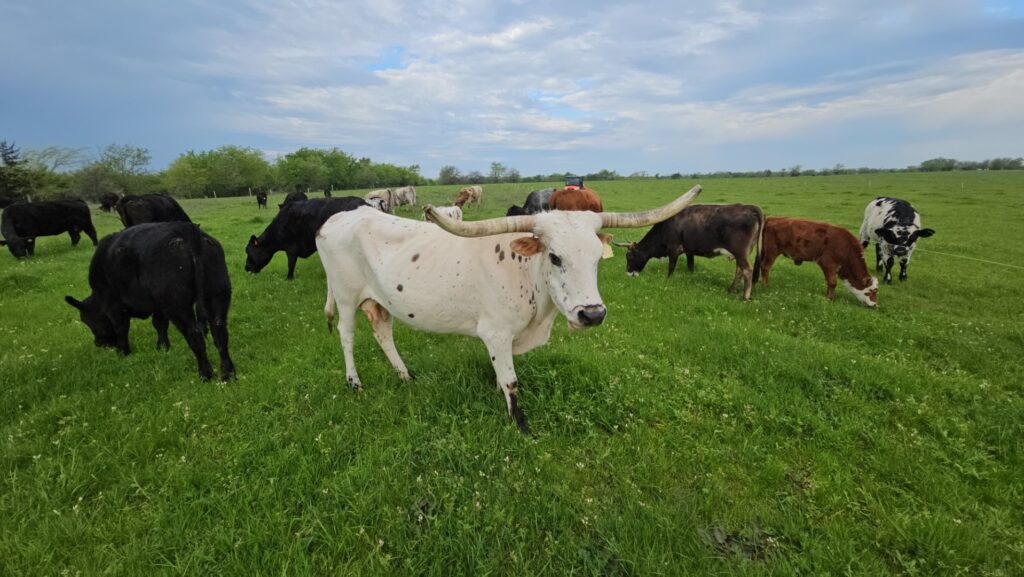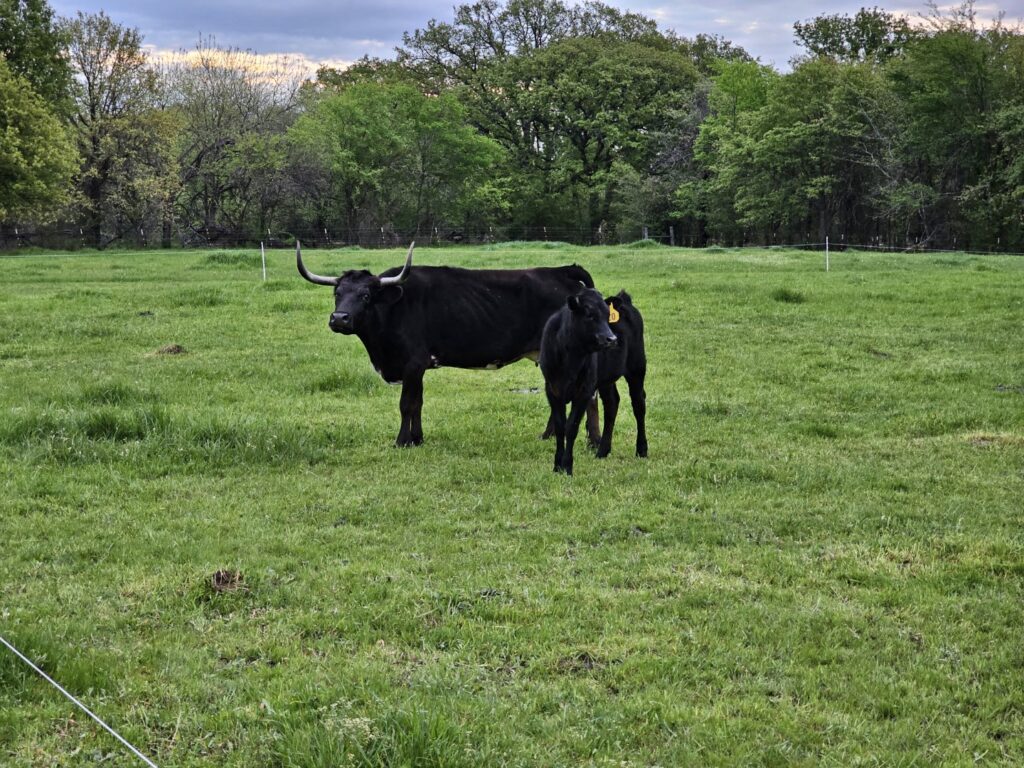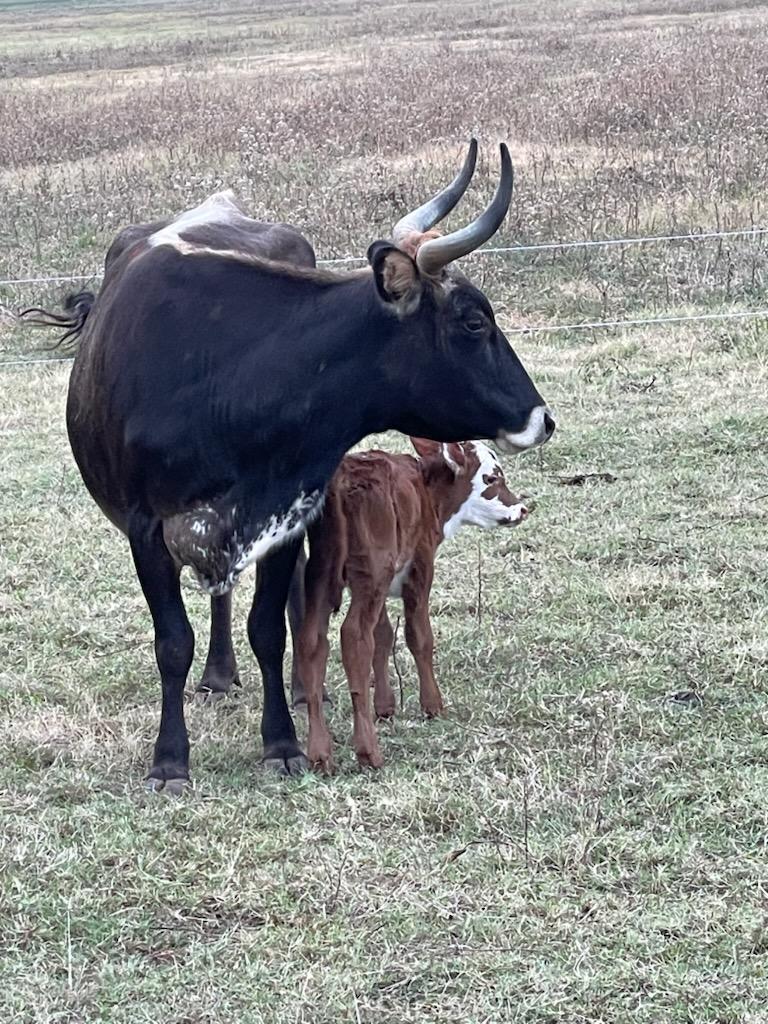Summary
Cattle are an essential part of my operation. Although I make more money per acre with sheep, cattle help regenerate the soil.
Goals
My target is 50% of my AUs for cattle, with 1/2 cow-calf pairs and 1/2 steer. Currently, I have access to 80 acres, and at 2 acres per AU, that means I can raise 10 cows and 10 steer.
Currently, my plan is to transition to the South Poll breed and run a cow-calf operation. The expected timeline for this transition is:
2025-2026: Calves are 1/2 South Poll. Sell all the current cows (except maybe the Brangus #10).
2027-2028: Using the 1/2 South Poll heifers, breed back to get 3/4 South Poll calves. I may switch out the bull as well. Sell off the 1/2 South Poll cows as the heifer calves are able to breed.
2029-2030: Using the 3/4 South Poll heifers, breed back 7/8 South Poll calves. Again, maybe switch out the bull with another South Poll bull.
2031+: Focus on genetics rather than breed. Although I will cull calves or cows that don’t perform up to expectations throughout the transition period, the priority was getting “pure bred” South Polls that are adapted to my farm and style. From 2031 onwards, the focus will be simply improving the genetics of my herd, keeping the cows that perform well, letting the ones that don’t go, and finding good bulls to bring better genetics into the herd.
In addition to the cow-calf operation, I’ll be keeping most of the steer to raise to weight and sell directly to customers. Having half of the cattle AUs in steer should allow me to respond quickly to drought conditions.
Why Cattle?
Wherever you find civilization, you find cattle. Cattle have been living symbiotically with humans for all of recorded history. They depend on us as much as we depend on them. We protect them from predators and provide them with fresh pasture, and they provide us with meat, milk, leather, and, in times past, energy.
The meat and milk of cows are exceptionally healthy for humans, as we are re-discovering. Animal fats such as tallow from beef cattle are also found to be superior to seed oils.
In this modern age, we are re-discovering that cattle are the key ingredient to turning wasteland into farmland. Their grazing habits and manure can convert deserts to fertile plains. The grass that grows to feed them will trap rain water, stop runoff, and build soil. Some people have seen inches of soil created each year in their pastures, thanks to cattle!
In North America, herds of millions and millions of buffalo used to roam the Great Plains. Those herds are gone now (due to disease, not hunting) but we can use cattle to restore the native prairie grasses, and with that will come all the native wildlife that used to be so common. So not only do cattle restore soil, but they can rebuild the native Great Plains habitat too!
Lifecycle
We run a “cow-calf” operation. This means we keep cows, breed them with bulls, and then raise the calves until they are about a year old. At that point, we have to decide whether to keep them or to sell them.
The cows we keep are kept for one of three reasons:
- Breeding cows are kept because they give birth to calves. They not only do all the hard work, but are self-sufficient and even feed the calves for us. They also provide protection to a degree from predators. Cows can breed for a very long time, decades even, under the right conditions. We aim to provide those conditions. On our farm, breeding cows can expect the best treatment possible.
- Heifers (female cows that have not yet had a calf) are kept either to replace our cows or to expand our herd. They should be 24 months old when they give birth to their first calf.
- Bulls (male cows that have not been castrated) are kept to breed. Bulls are virile at a young age, but are most effective at breeding by age 3 and beyond. For most of the year the bulls are kept separated from the cows. This is to ensure that calves are born at the optimum time, which in our climate is mid April.
- Steers (male cows that have been castrated) are raised to weight and then slaughtered for meat, which takes about 3 years. If they are finished on grass, they can take longer than grain-fed steer. Steer grow faster than bulls and provide the kind of meat most people are familiar with. While steer are living on our farm, they will have access to the best forage possible in the most natural environment possible.
Herds
- The Cow herd contains all of the breeding cows and their young calves. Bull calves must separate from the cow herd before 8 months old as they may breed with the cows. The heifer calves can stay with the cow herd until sale. Because we only have the bulls with the cows for a few months, we are guaranteed that the heifers won’t breed too early.
- The Bull/Steer Herd contains all of the breeding bulls and steer. The steer and bulls are given the best land and grass as the goal is to put as much weight on them as possible in as short a time as possible. It is important that the bulls do not mix with the cows outside of breeding season. It is fine for the steer and cows to mix, however.
- During breeding season, we can bring the two herds together.
- We can mix the herds with the sheep however we like, but I prefer keeping the rams with the cows and the sheep with the bulls and steer, because the numbers balance out.
Breeding Cycle
We follow the current regime as best as we can:
- March: Neuter bull calves for steer. Prepare heifer calves for sale.
- April-May: Calves are born.
- July-September: Put the bulls on the cows.
- September: Separate / wean bull calves.
Meet our Cows
As I am replacing my cows with the South Poll breed, these cows will be for sale in 2026 and 2027. If you’d like to purchase one, contact me: jgardner@jonathangardner.net
Our South Poll Bull is number 48. He was bought in 2024 and was born in August of 2023. Hopefully he bred all of our cows. We’ll find out in April of 2025!
I have another bull, a beautiful longhorn that I plan to harvest in June of 2025. He avoided sale by refusing to get on the trailer twice. I bought a cattle prod just for him (it didn’t work.) I was friendly with him when he was young and he likes to rub and nuzzle on me, which is very dangerous for a bull to do!
Red is a beautiful, big longhorn cow. Her coat is obviously red. She is the alpha cow. I will sell her in 2026.


Blue is actually white with black spots. That’s “blue” to our eyes, though. She is Red’s lieutenant. She will be sold in 2026. She’s probably half Corriente half Longhorn.

Yellow is a longhorn with a beautiful white-brown-yellow pattern. She will be sold in 2026. She is Patch’s mom.

Speck is a white longhorn with some black spots. She will be sold in 2026.

Blackie is mostly Corriente but there is probably some longhorn in there somewhere. She has a black coat with white markings. She is small but a trooper. She will be sold in 2026.
Blackie gave birth to Young #20, whose calf #48 is still around.

Brownie is also mostly Corriente, and has a brown coat with white markings. She is also my smallest cow. She will be sold in 2026.

#10 has the slickest coat and puts on fat when other cows cannot. She is half Angus and half Brahman, what people call “Brangus” down here. She has droopy ears and a lot of Brahman features. She is #11’s mom. I may not sell her at all.
#6 is a black angus. She’s shy but a trooper. She likes to hide from me like a ninja. She will probably be sold in 2027.
#19 is probably the second best cow in the herd. She is a black Angus cross. She will be sold in 2027. #4 is her calf.
#20 is the friendliest cow in the herd. She is also an Angus cross. In 2023 she was not well but she seems a lot better now. She’s not the best performing cow but she is not the worst either. She’ll be sold in 2027.
Metal Tag has a metal tag and is a black angus. She performs decently compared to the other cows. She gave me the white no-number calf born in October of 2021. She’ll be sold in 2027.
#413 was born in June of 2021. She had her first calf in 2024. She is a longhorn cross, white with black markings. She’ll be sold in 2026.
No number is a black longhorn cross born in June of 2021. She had her first calf in 2024. She’ll be sold in 2027.
The other no number is another black longhorn cross born in August 2021. She had a calf in 2024. She’ll be sold in 2026 or 2027.
#4 is one of the first calves I tagged, born in September of 2021 to #19. She had her first calf in 2024, which I kept as one of the best steer. She’ll be sold in 2027.
White no number is half Charolais born in October of 2021. She gave me her first calf in 2024. She’ll be sold in 2027.
#11 is #10’s daughter and thus 1/4 Brahman. She’s black and was born in February of 2022. She had her first calf in 2024. She’ll be sold in 2027.
#14 is half Charolais and born in May of 2022. She had her first calf in 2024. She’ll be sold in 2027.
Young #20 is half Corriente. She’s totally black though, born in 2022 and had her first calf in July of 2024, #48. Because she had a late calf she may not be bred and will be sold in late 2025.
Patches was born in November of 2022 to Yellow. She has not had a calf yet. She’ll be sold in 2026 or 2027.
#40 and #44 are steer born in February and March of 2024 to Brownie and #4. I am going to raise them to weight and have them slaughtered in 2027.
#48 was born in July of 2024 to Young #20. She will be sold probably in late 2025.